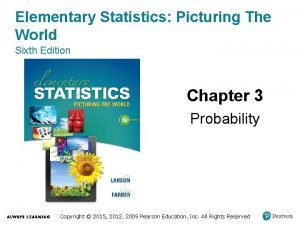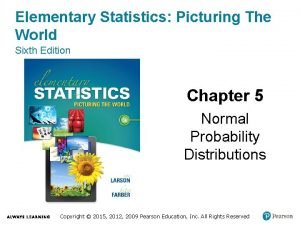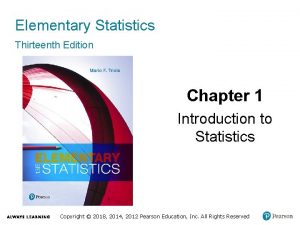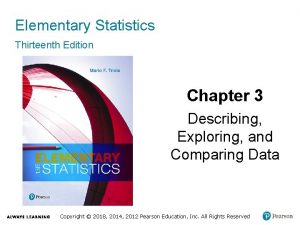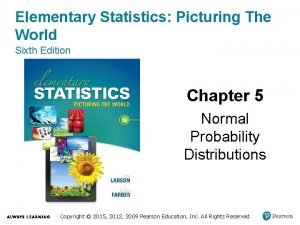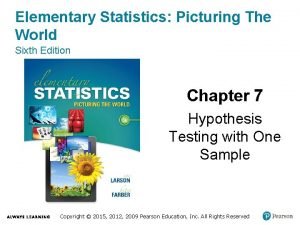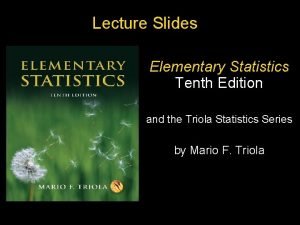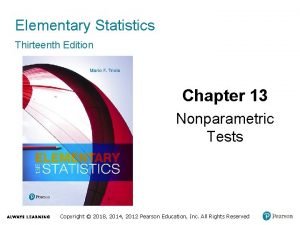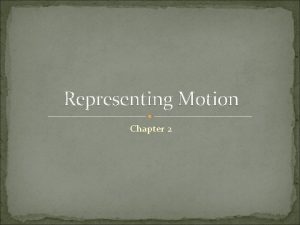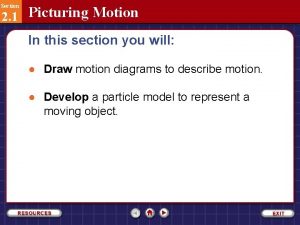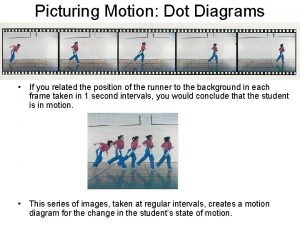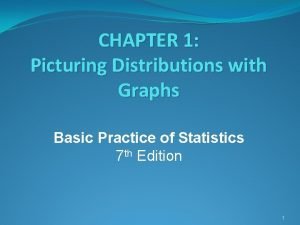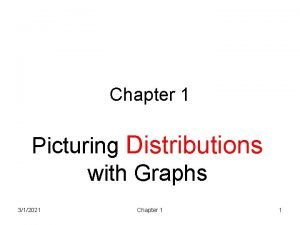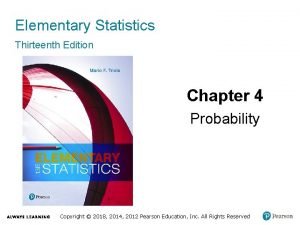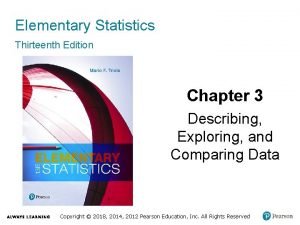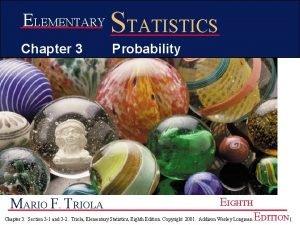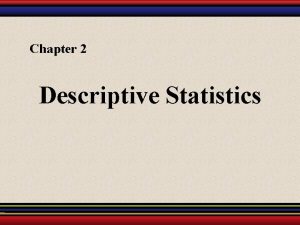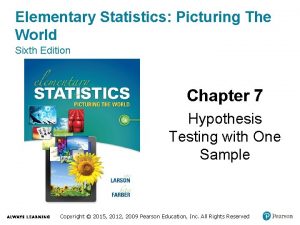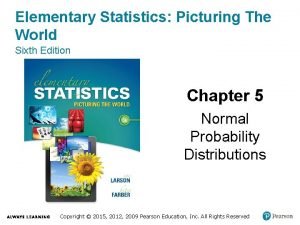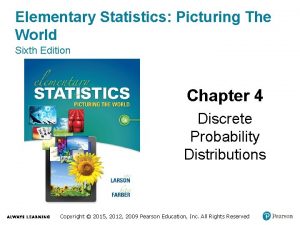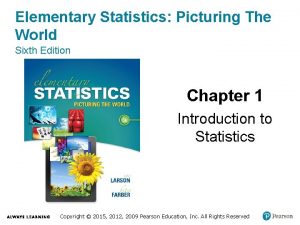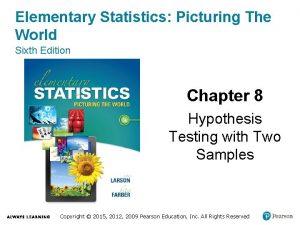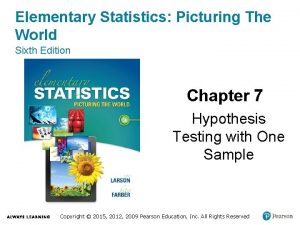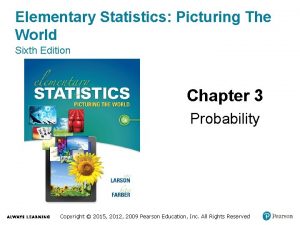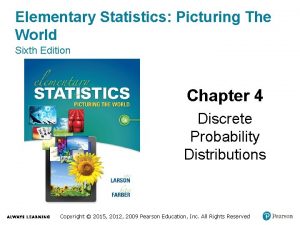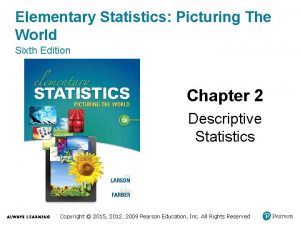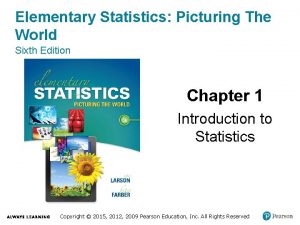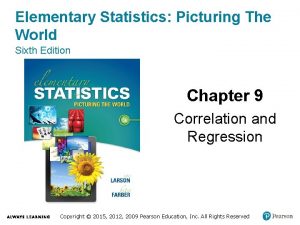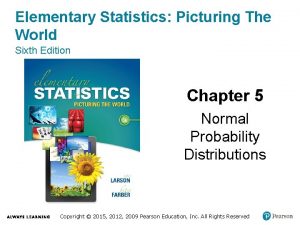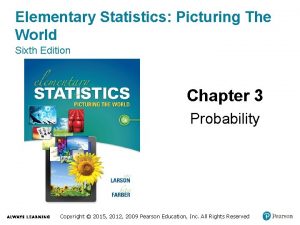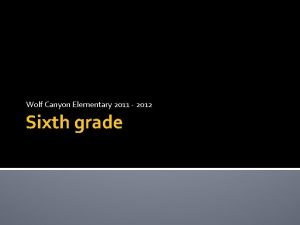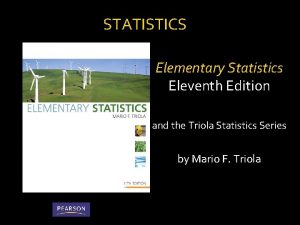Elementary Statistics Picturing The World Sixth Edition Chapter



























- Slides: 27

Elementary Statistics: Picturing The World Sixth Edition Chapter 4 Discrete Probability Distributions Copyright © 2015, 2012, 2009 Pearson Education, Inc. All Rights Reserved

Chapter Outline 4. 1 Probability Distributions 4. 2 Binomial Distributions 4. 3 More Discrete Probability Distributions Copyright © 2015, 2012, 2009 Pearson Education, Inc. All Rights Reserved

Section 4. 1 Probability Distributions Copyright © 2015, 2012, 2009 Pearson Education, Inc. All Rights Reserved

Section 4. 1 Objectives • How to distinguish between discrete random variables and continuous random variables • How to construct a discrete probability distribution and its graph and how to determine if a distribution is a probability distribution • How to find the mean, variance, and standard deviation of a discrete probability distribution • How to find the expected value of a discrete probability distribution Copyright © 2015, 2012, 2009 Pearson Education, Inc. All Rights Reserved

Random Variables (1 of 3) Random Variable • Represents a numerical value associated with each outcome of a probability distribution. • Denoted by x • Examples – x = Number of sales calls a salesperson makes in one day. – x = Hours spent on sales calls in one day. Copyright © 2015, 2012, 2009 Pearson Education, Inc. All Rights Reserved

Random Variables (2 of 3) Discrete Random Variable • Has a finite or countable number of possible outcomes that can be listed. • Example – x = Number of sales calls a salesperson makes in one day. Copyright © 2015, 2012, 2009 Pearson Education, Inc. All Rights Reserved

Random Variables (3 of 3) Continuous Random Variable • Has an uncountable number of possible outcomes, represented by an interval on the number line. • Example – x = Hours spent on sales calls in one day. Copyright © 2015, 2012, 2009 Pearson Education, Inc. All Rights Reserved

Example 1: Random Variables Decide whether the random variable x is discrete or continuous. 1. x = The number of Fortune 500 companies that lost money in the previous year. Solution Discrete random variable (The number of companies that lost money in the previous year can be counted. ) Copyright © 2015, 2012, 2009 Pearson Education, Inc. All Rights Reserved

Example 2: Random Variables Decide whether the random variable x is discrete or continuous. 2. x = The volume of gasoline in a 21 -gallon tank. Solution Continuous random variable (The amount of gasoline in the tank can be any volume between 0 gallons and 21 gallons. ) Copyright © 2015, 2012, 2009 Pearson Education, Inc. All Rights Reserved

Discrete Probability Distributions Discrete probability distribution • Lists each possible value the random variable can assume, together with its probability. • Must satisfy the following conditions: In Words In Symbols 1. The probability of each value of the discrete random variable is between 0 and 1, inclusive. 2. The sum of all the probabilities is 1. 0 P(x) 1 Copyright © 2015, 2012, 2009 Pearson Education, Inc. All Rights Reserved ΣP(x) = 1

Constructing a Discrete Probability Distribution Let x be a discrete random variable with possible outcomes x 1, x 2, … , xn. 1. Make a frequency distribution for the possible outcomes. 2. Find the sum of the frequencies. 3. Find the probability of each possible outcome by dividing its frequency by the sum of the frequencies. 4. Check that each probability is between 0 and 1 and that the sum is 1. Copyright © 2015, 2012, 2009 Pearson Education, Inc. All Rights Reserved

Example: Constructing a Discrete Probability Distribution (1 of 4) An industrial psychologist administered a personality inventory test for passive-aggressive traits to 150 employees. Individuals were given a score from 1 to 5, where 1 was extremely passive and 5 extremely aggressive. A score of 3 indicated neither trait. Construct a probability distribution for the random variable x. Then graph the distribution using a histogram. Score, x Frequency, f 1 24 2 33 3 42 4 30 5 21 Copyright © 2015, 2012, 2009 Pearson Education, Inc. All Rights Reserved

Example: Constructing a Discrete Probability Distribution (2 of 4) Solution • Divide the frequency of each score by the total number of individuals in the study to find the probability for each value of the random variable. x 1 2 3 4 5 P(x) 0. 16 0. 22 0. 28 0. 20 0. 14 Copyright © 2015, 2012, 2009 Pearson Education, Inc. All Rights Reserved

Example: Constructing a Discrete Probability Distribution (3 of 4) x 1 2 3 4 5 P(x) 0. 16 0. 22 0. 28 0. 20 0. 14 This is a valid discrete probability distribution since 1. Each probability is between 0 and 1, inclusive, 0 ≤ P(x) ≤ 1. 2. The sum of the probabilities equals 1, ΣP(x) = 0. 16 + 0. 22 + 0. 28 + 0. 20 + 0. 14 = 1. Copyright © 2015, 2012, 2009 Pearson Education, Inc. All Rights Reserved

Example: Constructing a Discrete Probability Distribution (4 of 4) Because the width of each bar is one, the area of each bar is equal to the probability of a particular outcome. Copyright © 2015, 2012, 2009 Pearson Education, Inc. All Rights Reserved

Mean of a discrete probability distribution • µ = Σx. P(x) • Each value of x is multiplied by its corresponding probability and the products are added. Copyright © 2015, 2012, 2009 Pearson Education, Inc. All Rights Reserved

Example: Finding the Mean The probability distribution for the personality inventory test for passive-aggressive traits is given. Find the mean. Solution x 1 2 3 P(x) 0. 16 0. 22 0. 28 4 5 0. 20 0. 14 Copyright © 2015, 2012, 2009 Pearson Education, Inc. All Rights Reserved

Finding the mean with a calculator Copyright © 2015, 2012, 2009 Pearson Education, Inc. All Rights Reserved

Finding the mean with a calculator Copyright © 2015, 2012, 2009 Pearson Education, Inc. All Rights Reserved

Variance and Standard Deviation Copyright © 2015, 2012, 2009 Pearson Education, Inc. All Rights Reserved

Example: Finding the Variance and Standard Deviation (1 of 2) The probability distribution for the personality inventory test for passive-aggressive traits is given. Find the variance and standard deviation. (µ = 2. 94) x 1 2 3 4 5 P(x) 0. 16 0. 22 0. 28 0. 20 0. 14 Copyright © 2015, 2012, 2009 Pearson Education, Inc. All Rights Reserved

Example: Finding the Variance and Standard Deviation (2 of 2) Solution Recall (µ = 2. 94) x P(x) x–µ 1 0. 16 1 – 2. 94 = – 1. 94 2 0. 22 2 – 2. 94 = – 0. 94 3 0. 28 3 – 2. 94 = 0. 06 4 0. 20 4 – 2. 94 = 1. 06 5 0. 14 5 – 2. 94 = 2. 06 Copyright © 2015, 2012, 2009 Pearson Education, Inc. All Rights Reserved

Expected Value Expected value of a discrete random variable • Equal to the mean of the random variable. • E(x) = µ = Σx. P(x) Copyright © 2015, 2012, 2009 Pearson Education, Inc. All Rights Reserved

Example: Finding an Expected Value (1 of 3) At a raffle, 1500 tickets are sold at $2 each for four prizes of $500, $250, $150, and $75. You buy one ticket. What is the expected value of your gain? Copyright © 2015, 2012, 2009 Pearson Education, Inc. All Rights Reserved

Example: Finding an Expected Value (2 of 3) Solution • To find the gain for each prize, subtract the price of the ticket from the prize: – – Your gain for the $500 prize is $500 – $2 = $498 Your gain for the $250 prize is $250 – $2 = $248 Your gain for the $150 prize is $150 – $2 = $148 Your gain for the $75 prize is $75 – $2 = $73 • If you do not win a prize, your gain is $0 – $2 = –$2 Copyright © 2015, 2012, 2009 Pearson Education, Inc. All Rights Reserved

Example: Finding an Expected Value (3 of 3) Copyright © 2015, 2012, 2009 Pearson Education, Inc. All Rights Reserved

Section 4. 1 Summary • Distinguished between discrete random variables and continuous random variables • Constructed a discrete probability distribution and its graph and determined if a distribution is a probability distribution • Found the mean, variance, and standard deviation of a discrete probability distribution • Found the expected value of a discrete probability distribution Copyright © 2015, 2012, 2009 Pearson Education, Inc. All Rights Reserved
 Elementary statistics picturing the world 6th edition
Elementary statistics picturing the world 6th edition Elementary statistics picturing the world 6th edition
Elementary statistics picturing the world 6th edition Elementary statistics 13th edition chapter 1
Elementary statistics 13th edition chapter 1 The sixth sheik's sixth sheep's sick
The sixth sheik's sixth sheep's sick The sixth sick sheik's sixth sheep's sick lyrics
The sixth sick sheik's sixth sheep's sick lyrics Elementary statistics 13th edition answers
Elementary statistics 13th edition answers Elementary statistics 6th edition
Elementary statistics 6th edition Elementary statistics 6th edition
Elementary statistics 6th edition Elementary statistics tenth edition
Elementary statistics tenth edition Elementary statistics 13th edition
Elementary statistics 13th edition Biochemistry sixth edition 2007 w.h. freeman and company
Biochemistry sixth edition 2007 w.h. freeman and company Computer architecture a quantitative approach sixth edition
Computer architecture a quantitative approach sixth edition Automotive technology sixth edition
Automotive technology sixth edition Automotive technology sixth edition
Automotive technology sixth edition Apa sixth edition
Apa sixth edition Computer architecture a quantitative approach 6th
Computer architecture a quantitative approach 6th Precalculus sixth edition
Precalculus sixth edition Principles of economics sixth edition
Principles of economics sixth edition Computer architecture a quantitative approach sixth edition
Computer architecture a quantitative approach sixth edition Chapter 2 visual 1 motion diagrams
Chapter 2 visual 1 motion diagrams Picturing motion
Picturing motion Constant velocity dot diagram
Constant velocity dot diagram Picturing distributions with graphs
Picturing distributions with graphs Picturing distributions with graphs
Picturing distributions with graphs 5% guideline for cumbersome calculations
5% guideline for cumbersome calculations Elementary statistics chapter 3
Elementary statistics chapter 3 Elementary statistics chapter 3 answers
Elementary statistics chapter 3 answers Elementary statistics chapter 2
Elementary statistics chapter 2
